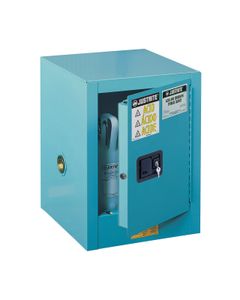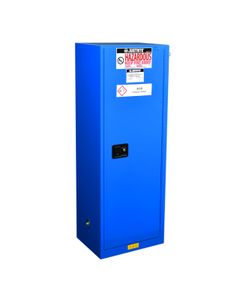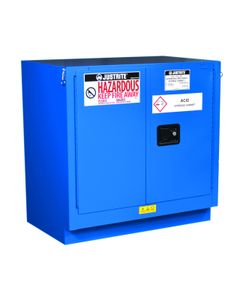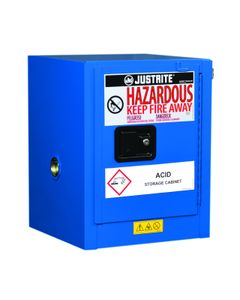Catégories
Armoires de sécurité pour les matériaux dangereux
Nos armoires de sécurité pour matières dangereuses sont conçues pour répondre aux exigences du code NFPA 400 relatif aux matières dangereuses, qui se concentre spécifiquement sur la manipulation et le stockage des matières dangereuses. Chaque armoire est équipée d’une étiquette réfléchissante Haz-Alert , portant la mention « Dangereux -Tenir le feu à l’écart », ainsi que d’un paquet de dix étiquettes spécifiques à l’application à choisir et à appliquer sur l’armoire afin d’indiquer son contenu. Toutes les armoires sont équipées de portes à fermeture automatique, et beaucoup sont disponibles avec revêtement ChemCor® pour les applications qui nécessitent une protection contre les corrosifs agressifs.
Lire la suite

Armoires de sécurité d’établi en acier Sure-Grip® EX pour produits corrosifs 89021-CT Justrite armoire de stockage pour produits dangereux Bleu
Protéger le personnel et les laboratoires de produits chimiques nocifs en stockant des substances corrosives dans des armoires de sécurité spécialement conçues
Disponible en 2 versions

Armoires de sécurité Slimline doublées ChemCor® pour matériaux dangereux 86821-SL Justrite
La finition sans soudure ChemCor® protège les surfaces intérieures de l’armoire contre la rouille et la corrosion
Disponible en 1 versions

Armoires de sécurité Compac doublées ChemCor® pour matériaux dangereux 86821-CM Justrite
La finition sans soudure ChemCor® protège les surfaces intérieures de l’armoire contre la rouille et la corrosion
Disponible en 1 versions

Armoires de sécurité classiques doublées ChemCor® pour matériaux dangereux 86821-CL Justrite
La finition sans soudure ChemCor® protège les surfaces intérieures de l’armoire contre la rouille et la corrosion
Disponible en 3 versions

Armoires de sécurité encastrables doublées ChemCor® 86821-UC Justrite
La finition sans soudure ChemCor® protège les surfaces intérieures de l’armoire contre la rouille et la corrosion
Disponible en 1 versions

Armoires de sécurité d’établi doublées ChemCor® 86821-CT Justrite
La finition sans soudure ChemCor® protège les surfaces intérieures de l’armoire contre la rouille et la corrosion
Disponible en 1 versions

Armoires de sécurité empilables doublées ChemCor® pour matériaux dangereux 86821-PG Justrite
La finition sans soudure ChemCor® protège les surfaces intérieures de l’armoire contre la rouille et la corrosion
Disponible en 2 versions
FAQ sur Armoires de sécurité pour les matériaux dangereux
What types of chemicals should be stored in these cabinets?
These cabinets are intended to store corrosive solids and liquids, flammable solids, organic peroxide formulations, oxidizer solids and liquids, pyrophoric solids and liquids, toxic or highly toxic solids and liquids, unstable (reactive) solids or liquids, and water-reactive solids or liquids. Always ensure that incompatible materials are stored in separate cabinets, and consult your local code authority for any other items in question.
What types of chemicals SHOULD NOT be stored in these cabinets?
Do not use hazardous material cabinets to store pressurized gas cylinders, cryogenic fluids, or flammable and combustible liquids. For more information on these restricted hazardous material categories, please see NFPA 55 Compressed Gases and Cryogenic Fluids Code, and NFPA 30 Flammable and Combustible Liquids Code. Please consult your local code authority for any other items in question.
What if I have a hazardous liquid that is also flammable?
Recognized protocol takes flammable liquid hazard as precedence in the hierarchy of other hazards. In these cases, store the flammable liquid in one of Justrite’s many varieties of flammable safety cabinets, i.e., our yellow safety cabinets. If harsh corrosives are a concern, then the end user has the option of purchasing a polyethylene tray for the shelf to protect against spills.
How are these cabinets different from the current Justrite steel acid cabinets?
The physical construction of the hazardous material safety cabinet is similar to Justrite’s current flammable or corrosive (acid) cabinets, including 18-gauge double walled steel with 1.5-inch of insulating air space, 2-inch leakproof sump, and dual vents with flame arresters. The first difference is that the regulations require hazardous material cabinets to have self-closing doors. As a result, manual style doors are not an option in this group. The other difference is in the labeling of the cabinet. Also mandated by code, each cabinet comes with a HAZARDOUS - KEEP FIRE AWAY Haz-Alert™ warning label affixed prominently on the front door of the cabinet. The reflective material is highly visible in fire conditions when illuminated with a flashlight. The second set of labels, while not required by code, provide critical “Right to Know” information for those that come in contact with the cabinet.
Intended to store specific classifications of hazardous materials, the cabinets come with “Acid” and “Base” labels along with eight distinct hazardous material classification labels, including: Pyrophoric, Oxidizer, Self-Reactive, Toxic, Water-Reactive, Corrosive, Flammable Solid, and Organic Peroxide. Designed using pictograms and elements from the Globally Harmonized System of Classification and Labeling of Chemicals (GHS), these labels are included in the packaging, and the customer can select and apply the most appropriate label(s) for their application. They serve a dual purpose in helping the end user properly store and segregate incompatible chemicals, and in the event of an emergency, warn individuals and first responders to heed caution in the proximity of the cabinet.
Will I still be able to purchase the blue acid cabinets currently offered by Justrite?
The existing acid cabinets are available for purchase, but please check with your authority having jurisdiction and / or insurance company to determine the model cabinet for your application that best complies with the local codes and regulations in your particular jurisdiction.
What happens with all the blue steel acid cabinets that I currently own?
Local authorities can grandfather in the current acid cabinets, although it is important to check with your AHJ to be sure. The physical construction of the new hazardous material safety cabinet is similar to Justrite’s current flammable or corrosive (acid) cabinets. But because the new codes require these cabinets to have self-closing doors, existing acid cabinets that don’t have self-closing doors may be subject to additional scrutiny. Aside from the construction and color, the most noticeable difference is in the labeling of the cabinet with the use of a HAZARDOUS – KEEP FIRE AWAY label.
To ensure your acid safety cabinets are in full regulatory compliance for hazardous materials, you may purchase from your Justrite distributor a separate retrofit pack of hazardous material labels (Justrite Model number 29017), which includes a HAZARDOUS - KEEP FIRE AWAY label, and a pack of ten hazardous material classification labels including: Acid and Base labels; Pyrophoric, Oxidizer, Self-Reactive, Toxic, Water-Reactive, Corrosive, Flammable Solid, and Organic Peroxide labels. A Lithium-Ion Battery classification label (Justrite Model number 29018) is also available.
References: NFPA 1, NFPA 400, and IFC






